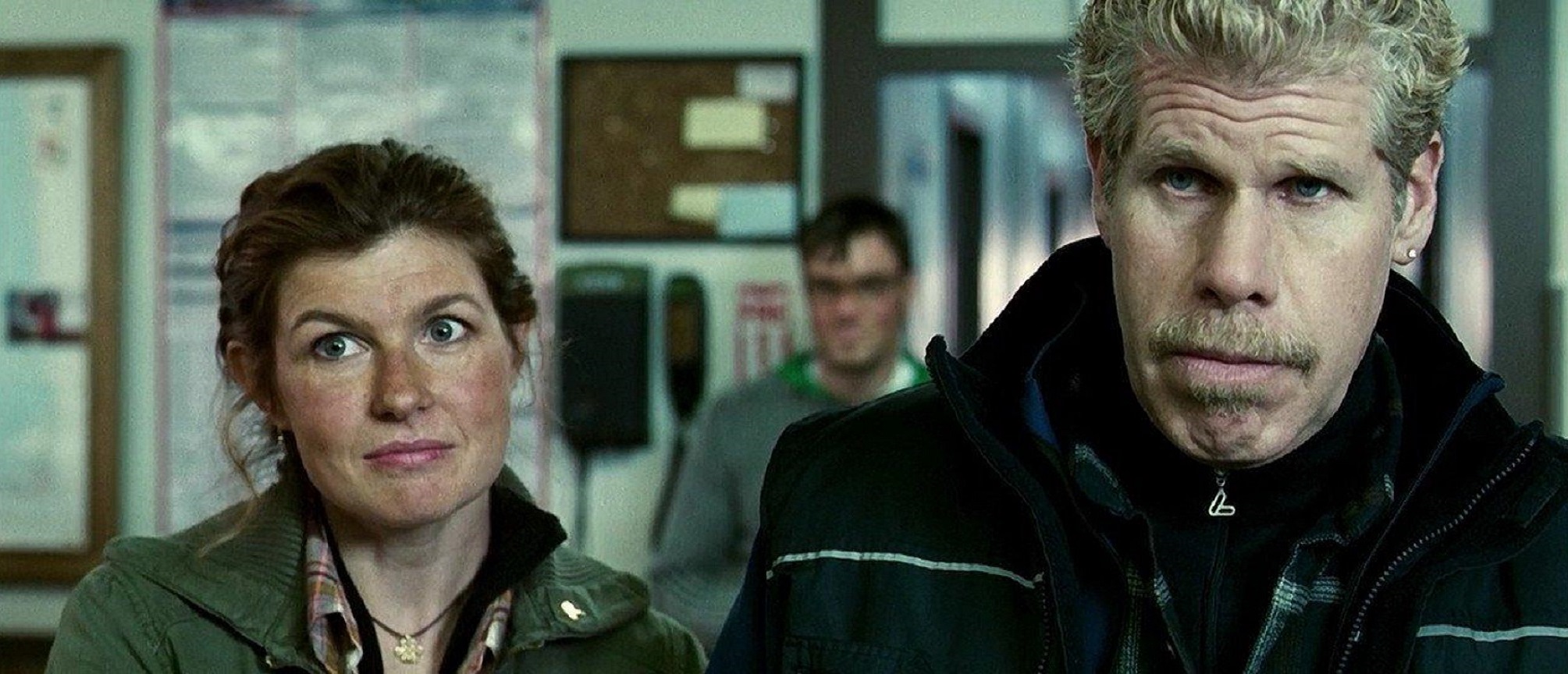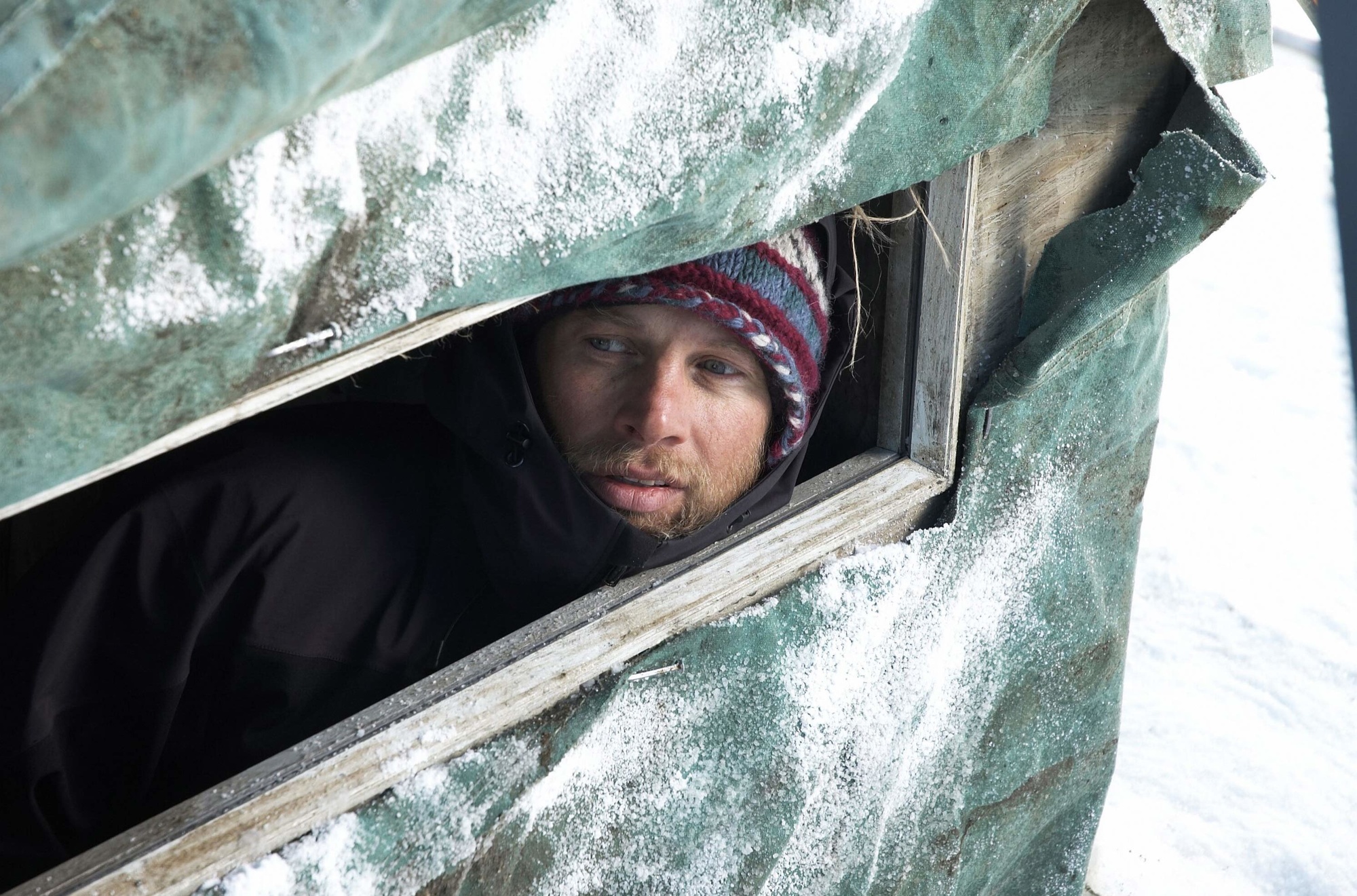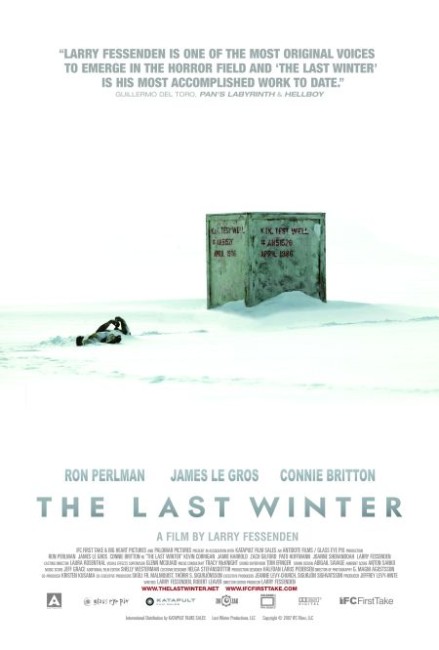USA/Iceland. 2006.
Crew
Director/Producer – Larry Fessenden, Screenplay – Larry Fessenden & Robert Leaver, Photography – G. Magni Agustsson, Music – Jeff Grace, Visual Effects Supervisor – Glenn McQuaid, Special Effects Supervisor – Eggert ‘Eddi’ Ketilsson, Production Design – Halfdan Larus Pedersen. Production Company – The Weinstein Company/IFC Films/Glass Eye Pix/Big Heart Pictures/Palomar Pictures/Katapult Film Sales/Zik Zak Filmworks/The Icelandic Film Centre/Antidote Films.
Cast
Ron Perlman (Ed Pollock), James Le Gros (James Hoffman), Connie Britton (Abby Sellers), Zach Gilford (Maxwell McKinder), Jamie Harrold (Elliot Taylor), Kevin Corrigan (Motor), Joanne Shenandoah (Dawn Russell), Pato Hoffmann (Lee Means)
Plot
Ed Pollock flies in to a small research base in the Alaskan permafrost to supervise the set up of that season’s drilling projects on behalf of North Industries. The problem is that the ice has not frozen enough this season to allow them to bring in the heavy equipment for the drilling. The team’s environmental scientist James Hoffman is unwilling to sign off on Ed’s plan to use heavy rolligons to transport the equipment, which will damage the environment. Hoffman is certain that something strange is happening out there but not what. One of the team, Maxwell, goes missing for several hours after being drawn to the old sealed-up K.I.K. drill test site and returns in a shell-shocked state, talking about ghosts emerging from beneath the ground. As night settles in, Hoffman observes that the crew in the base are acting strangely and seem to be becoming obsessed. As this culminates in a series of fatal accidents, Hoffman believes that what is beneath the ice is emerging to take revenge against humanity for its despoliation of the environment.
Director, writer and actor Larry Fessenden is a talent that has always bubbled beneath the radar of popular interest. He has directed a number of low-budget horror films with No Telling (1991) and the vampire film Habit (1997), before graduating to the better budgeted Wendigo (2001) and subsequent to this the monster movie Beneath (2013), the modernised Frankenstein retelling Depraved (2019) and the werewolf film Blackout (2023), as well as the N is for Nexus segment of ABCs of Death 2 (2014) and the Fever episode of Isolation (2021). Fessenden has also acted as a producer for a number of other horror films via his Glass Eye Pix production company, including the likes of The Off Season (2004), Zombie Honeymoon (2004), The Roost (2005), Automatons (2006), Trigger Man (2007), I Can See You (2008), I Sell the Dead (2008), The House of the Devil (2009), Satan Hates You (2009), Bitter Feast (2010), Stake Land (2010), Hypothermia (2011), The Innkeepers (2011), Late Phases (2014), Darling (2015), Most Beautiful Island (2017), Psychopaths (2017) and The Ranger (2018). Fessenden has also made a number of appearances in other films as an actor, including bit parts in Bringing Out the Dead (1999), Session 9 (2001), Broken Flowers (2005), The Brave One (2007), You’re Next (2011), We Are Still Here (2015) and The Dead Don’t Die (2019).
The Last Winter is an environmental horror film. The setting of a base in the Alaskan wilderness immediately recalls The Thing from Another World (1951) and The Thing (1982) – indeed, The Last Winter could be an existential version of The Thing where Larry Fessenden has kept the scenes of the crew at siege inside an Arctic base but has stripped any overt appearances of the monster from the film (for the greater part). Maybe a version of The Thing combined with the environmental vision of tv’s Edge of Darkness (1985) where the entire Earth seems to be rebelling against mankind’s exploitation. Or maybe even more so of the great Australian horror film Long Weekend (1978) where a couple on a remote beach are seemingly punished by nature for their polluting ways, where we also saw no overt menace throughout. That, and with maybe a few dashes of George A. Romero’s The Crazies (1973) thrown into the mix. There are also a number of similarities to Anthony Waller’s subsequent Nine Miles Down (2009).
In his films, Larry Fessenden always invests a good deal in sketching out the everyday lives of his characters. The drama of his films takes place embedded amongst the incidental detail of these. Particularly good in The Last Winter is the way that all eight characters on the station are drawn in subtle and well rounded shades. Fessenden takes his time during the build-up scenes with Ron Perlman’s arrival, his handing out gifts, the group playing football out in the snow. Ron Perlman is an actor who has always taken the less well-travelled road as an actor, playing roles either under a mountain of makeup or as supporting heavies.

Contrarily here, Larry Fessenden casts Perlman as an ordinary guy, a role that one stretches to think of having seen Perlman in before. Perlman plays the part extremely well – he takes the chance to open up with an entertaining gregariousness. The roles in the film could easily have fallen to cliche in another director or other actor’s hands – for example, it would have been extremely easy to cast Ron Perlman as the cliche of the hard-headed boss not caring about human life and steam-rollering over his crew’s concerns in order to get the job done up against James Le Gros’s good guy. To the contrary, Perlman goes to some length to show his humane responsibility towards the rest of the crew.
James Le Gros is equally good – just the calm and quietly patient way that he acts as the voice of reason throughout makes for an extremely understated performance. Neither character is a cliche and come rounded with subtle edges where Larry Fessenden and the actors find the hearts of the characters with an authenticity.
The Last Winter comes very much concerned with the debate at the time the film was made over drilling in the oil reserves in the Arctic National Wildlife Refuge in Alaska that became a particular hot button issue between the pro-oil George W. Bush White House and environmental groups wanting to preserve the pristine wilderness. Larry Fessenden is unapologetically on the side of the environmentalists. In this regard, he does striking things in investing the monster movie with unique new metaphors.
In the same way that the monsters in The Beast from 20,000 Fathoms (1953) and Godzilla, King of the Monsters (1954) acted as startling allegories for the atomic bomb in the 1950s, The Last Winter offers one of the most original new metaphors for the monster movie that one has seen in some time – the idea of ghosts emerging out of the crushed carboniferous oil in response to environmental destruction. As Zack Gilford hauntingly states at one point: “We’re grave robbers. It’s coming out from the ground. Ghosts. What is it anyway but fossils, plants and animals from whatever millions of years ago?”

The Last Winter develops slowly to arrive at a fervid cabin fever nightmare. The threat itself is a vague and never-fully seen one. We get partial glimpses – glowing shapes that we seem to think we see blowing in the flurry of snow but cannot be sure whether we do or not; something unseen that seems to creep up on Jamie Harrold in a barren plain of snow, leaving him with a bloodied nose; something that attacks Zack Gilford on the camcorder, only for the recording to be destroyed by Ron Perlman before it can be replayed. These become more overt at the very end where we do see creatures emerging out of the snowdrifts – but mostly the threat is a Lewtonian one that sits in ambiguities. The film arrives at an apocalyptically downbeat ending but even then the menace is not clearly seen.
The best scenes in the film come during Ron Perlman and James Le Gros’s peril-laden journey across the ice on snowmobile and then on foot, where Larry Fessenden throws in some dramatically gripping scenes with Perlman falling into a frozen-over river when the ice collapses and forced to carry on after losing his boot. Fessenden creates dazzling images such as Ron Perlman and James Le Gros sitting at a campfire while the aurora borealis plays out in the sky above them.
Larry Fessenden and co-writer Robert Leaver have clearly gone to Alaska and studied the environmental issues, the politics of mining in the area, even the nuts and bolts details of daily life on a station and the film bristles with a convincing description of these things. The outdoor scenery is stunningly well photographed. Although, for all its setting in Alaska, Larry Fessenden shot the entire film in Iceland.
(Nominee for Best Actor (Ron Perlman) at this site’s Best of 2006 Awards).
Trailer here


